Magnetic stimulation at acupoints relieves mental fatigue: An Event Related Potential (P300) study
Abstract
BACKGROUND:
Mental fatigue caused by continuous cognitive tasks represents one of the most worrying modern health problems. Event Related Potential (ERP) P300 is thought to be associated with cognitive function.
OBJECTIVE:
This study aimed at characterizing the neural activity correlated with the attentional processes and exploring a novelty method which combine the magnetic stimulation and acupoint to relieve mental fatigue caused by continuous cognitive tasks.
METHODS:
P300 (P3a and P3b) were extracted at three points: when subjects felt relaxed, at the point of mental fatigue, and after the subjects were stimulated at acupoints. The amplitudes and latencies of P3a and P3b were analyzed statistically.
RESULTS:
Among the four features (P3a amplitude, P3a latency, P3b amplitude, and P3b latency), only P3b amplitude was found to have a significant difference between the resting state and the mental fatigue state. And P3b amplitude significantly increased after magnetic stimulation at the acupoints.
CONCLUSIONS:
Subjects experiencing mental fatigue demonstrated a significant decrease in P3b amplitude in the parietal region, suggesting attenuation of resource allocation for selective attention. P3b amplitude significantly increased after magnetic stimulation at acupoints indicating that this strategy can be used to improve selective attention and relieve mental fatigue.
1.Introduction
In our daily life, more and more people are usually in a state of mental fatigue which is considered as a major health issue. It was defined by Grandjean (1980) as a state in which people show the decline in mental alertness and mental performance [1, 2]. Mental fatigue is a functional state between sleep and relaxed or waking state [3]. It may lead to temporary worsening of information processing functions. It can impair attention, motivation, cognitive control and even increase the number of behavioral errors [4, 5]. Excessive mental fatigue for a long time can cause neurasthenia, insomnia, depression, chronic fatigue syndrome (CFS), and so on [6, 7].
Acupuncture as a therapeutic intervention is one of the key components of the health care system in China. It is widely used in the United States and Europe since the National Institutes of Health (NIH) consensus proposed [8]. It presents a good clinical curative effect on CFS [7, 9]. Acupuncture can be used to alleviate physical and mental fatigue of CFS patients. And the therapeutic effect shows acupuncture at acupoints is better than that at non-acupoints [10, 11]. In present studies, acupuncture is still lack of quantitative acupuncture manipulation which might be the main constraining factor for the acupuncture treatment [12]. In order to quantify the treatment at acupoints, electrical stimulation is used to apply at acupoints instead of traditional manual acupuncture. In some researches, electrical stimulation has obtained the effect similar to acupuncture. However, electrical stimulation is painful. Magnetic stimulation provides a new stimulation technology without pain [13].
The first magnetic stimulator is proposed by Barker et al. in 1985 [14, 15]. During magnetic stimulation, high frequency current is applied in a coil which is also called magnetic field generator. The coil is generally placed over target tissues and generates a strong time-varying magnetic field. The magnetic field would induce eddy current in the target tissues [15]. Then the target is stimulated by eddy current. At the cellular lever, the tissues are stimulated by the current during whether electrical stimulation or magnetic stimulation. As it has the advantages of painless, contactless and easy to operate, magnetic stimulation is widely used in neuropsychiatric diseases and brain cognitive function researches as a diagnostic and therapeutic tool [16].
Table 1
Karolinska sleepiness scale
| Score | Verbal description |
|---|---|
| 1 | Extremely alert |
| 2 | Very alert |
| 3 | Alert |
| 4 | Rather alert |
| 5 | Neither alert nor sleepy |
| 6 | Some signs of sleepiness |
| 7 | Sleepy, but no effort to keep alert |
| 8 | Sleepy, some effort to keep alert |
| 9 | Very sleepy, great effort to keep alert |
| 10 | Fighting sleep |
In this paper, HT7 (SHENMEN), LI4 (HEGU) and PC8 (LAOGONG) points were stimulated by magnetic stimulator instead of acupuncture or electrical acupoint stimulation. In order to evaluate the availability of magnetic stimulation at acupoints, a late positive Event Related Potential (ERP) component P300 was recorded. ERP has excellent temporal resolution and has been thought to be an ideal indicator of mental activity [17]. It reflects the neurophysiological changes of brain during cognitive tasks. The amount of resources allocated to the target stimulus is thought to be reflected by P300 amplitude. The stimulus evaluation time which is irrelevant to response selection and execution processes could be measured by P300 latency [18]. Using P300, the effects of magnetic stimulation at acupoints on cognitive resource allocation and the corresponding response time during mental fatigue were analyzed.
2.Materials and methods
2.1Subjects
The subjects are fourteen volunteer students from 20 to 23 years of age. The average age is 21.6 years. All of them were acquainted with the nature and purpose of this study before consenting to participate. Each subject gave informed consent in the experiment. Chinese is their native languages.
2.2Experimental protocol
The experiment began at 9 am for every subject in order to minimize the effect of circadian variance. After enrollment, the subjects undertook the process outlined in Fig. 1. They performed a continuous cognitive task (reading English papers) for four hours until they felt the onset of mental fatigue. Then, they were stimulated at acupoints using a MagStim Rapid
The level of mental fatigue was assessed using the Karolinska Sleepiness Scale (KSS) [19] (Table 1).
Figure 1.
Schematic illustration of the experiment.

Figure 2.
Positions of three acupoints.
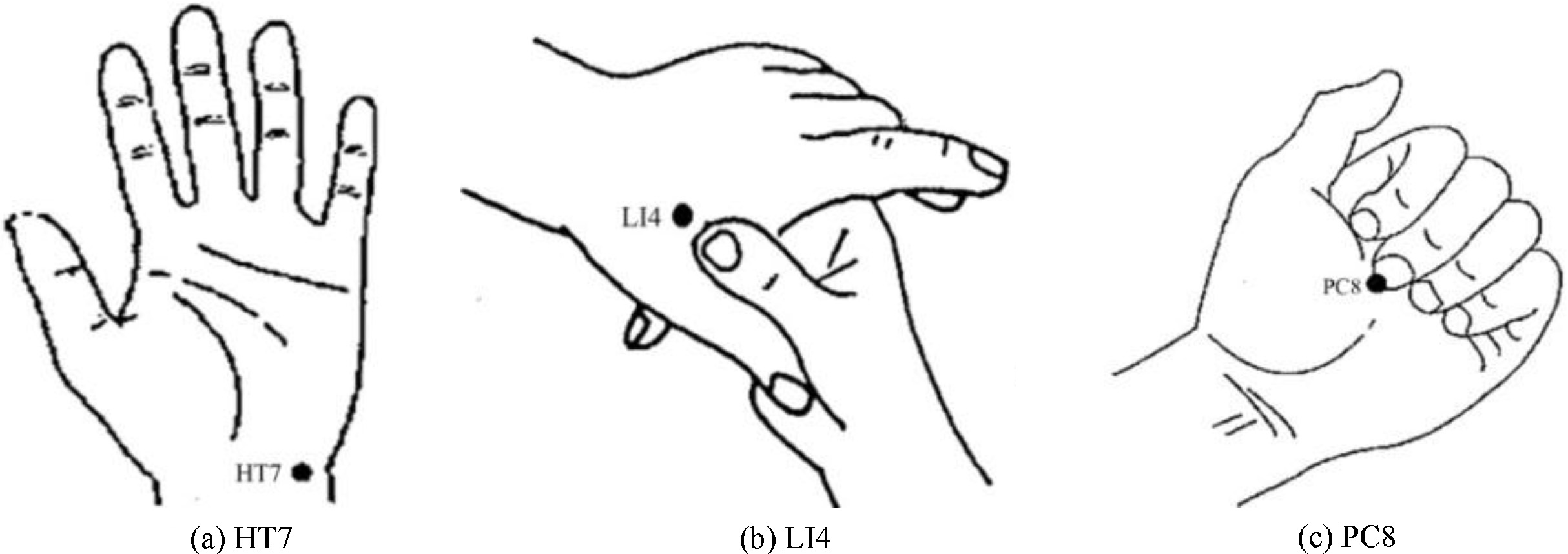
2.3ERP measurement
Subjects were presented binaurally via earphones with auditory stimulus produced by the program STIM2 (NeuroScan Co., USA). The study employed a novelty oddball task. Standard and target tones (100 ms duration, 500 Hz and 800 Hz frequency, 84% and 8% probability) interspersed with unique novel sounds (complex environmental sounds without repetition, like bird song, dripping water, and wind; 100 ms duration, 8% probability) were presented binaurally over headphones at 80 dB SPL in pseudorandom order, with an interstimulus interval (ISI) of 1000 ms. Subjects were asked to click the left mouse button when, and only when, they heard the standard tone and the right mouse button when, and only when, they heard the target tone. The total number of stimuli was 300.
2.4Magnetic stimulation at acupoints
According to Chinese acupuncture theory, acupuncture HT7, LI4 and PC8 points shown in Fig. 2 can relieve mental fatigue or CFS. Each subject was applied magnetic stimulation at the three acupoints.
Magnetic stimulation was carried out using a 70 mm standard double coil. The magnetic stimulation intensity was 1.76 T. The magnetic stimulation trial at each acupoint consisted of 90 stimulations at a frequency of 1 Hz. The inter-trial interval was 1 min.
2.5Data recording and analysis
Data were obtained from the 64-channel NeuroScan EEG system. And the electrode positions are shown in Fig. 3.
Figure 3.
EEG electrode positions.
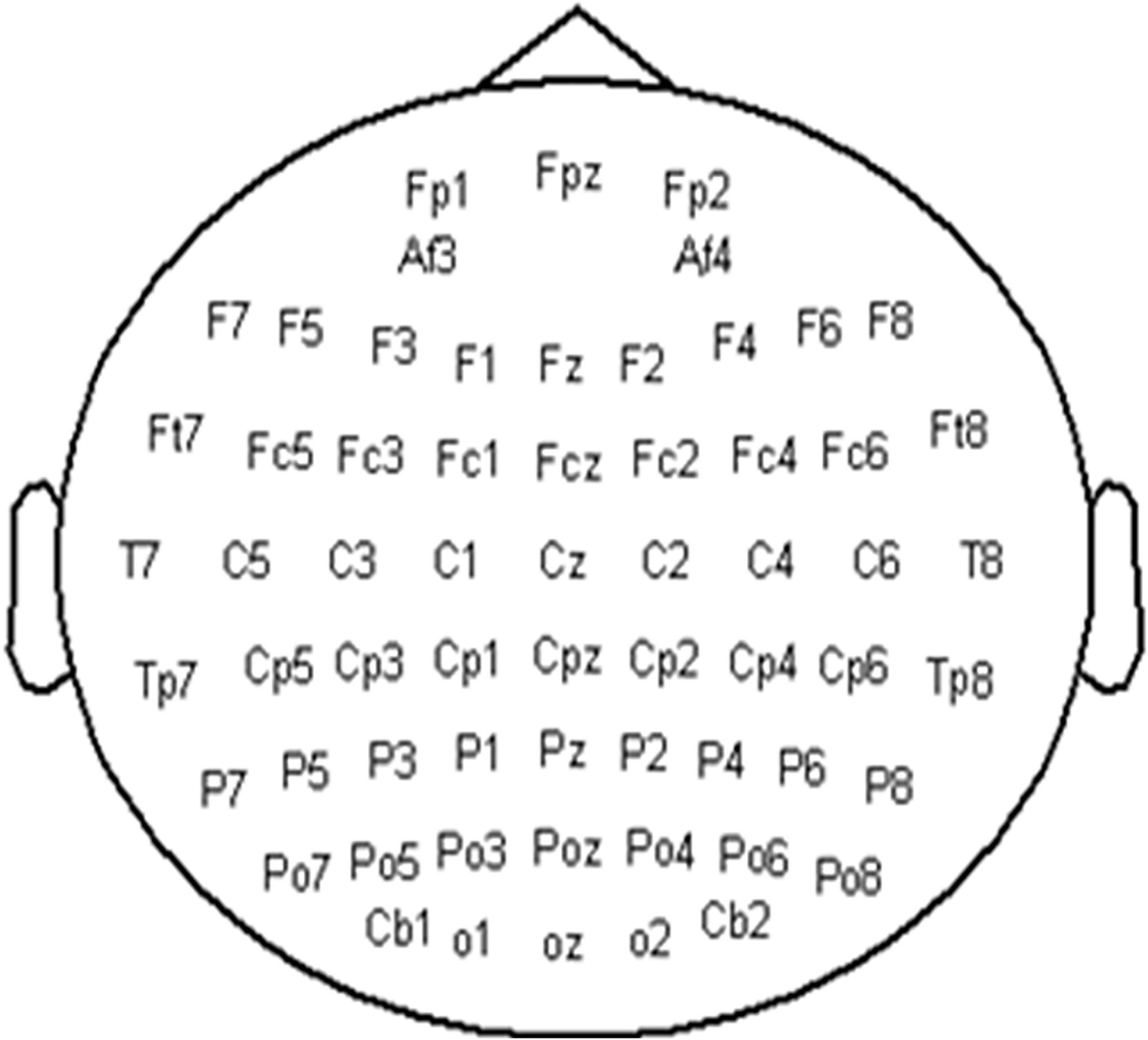
The electrode-scalp impedance in each channel is below 5. Sampling frequency of the EEG data is 1000 Hz. The data were band-pass filtered from 0.1 Hz to 24 Hz and were epoched from 100 ms pre-stimulus to 800 ms post-stimulus. Baseline correction was performed on the data using the pre-stimulus interval. The data with amplitudes greater than
2.6Statistical analysis
Paired t-test is used to compare the scores on the mental fatigue questionnaires. Statistical analysis was performed using SPSS19. Repeated-measures analysis of variance (ANOVA) with state (resting state vs. mental fatigue state) as a between-subject factor and electrode site as the within-subject factor was performed. ANOVA results helped to identify group differences in P3a amplitude, P3b amplitude, P3a latency, and P3b latency. The P300 maximum amplitude and latency at two states (mental fatigue state and recovery state) were compared using paired t-tests.
3.Results
3.1Fatigue scale
After the continuous cognitive task, the average score of the KSS increased from 3.50 (SD
3.2P3a
Because the P3a is generated from frontal activations [16, 17], P3a waveforms recorded by four electrodes (FP1, FP2, AF3 and AF4) were used for analysis. The grand-averaged P3a waveforms are shown in Fig. 4.
Figure 4.
Grand-averaged ERP waveforms of P3a.
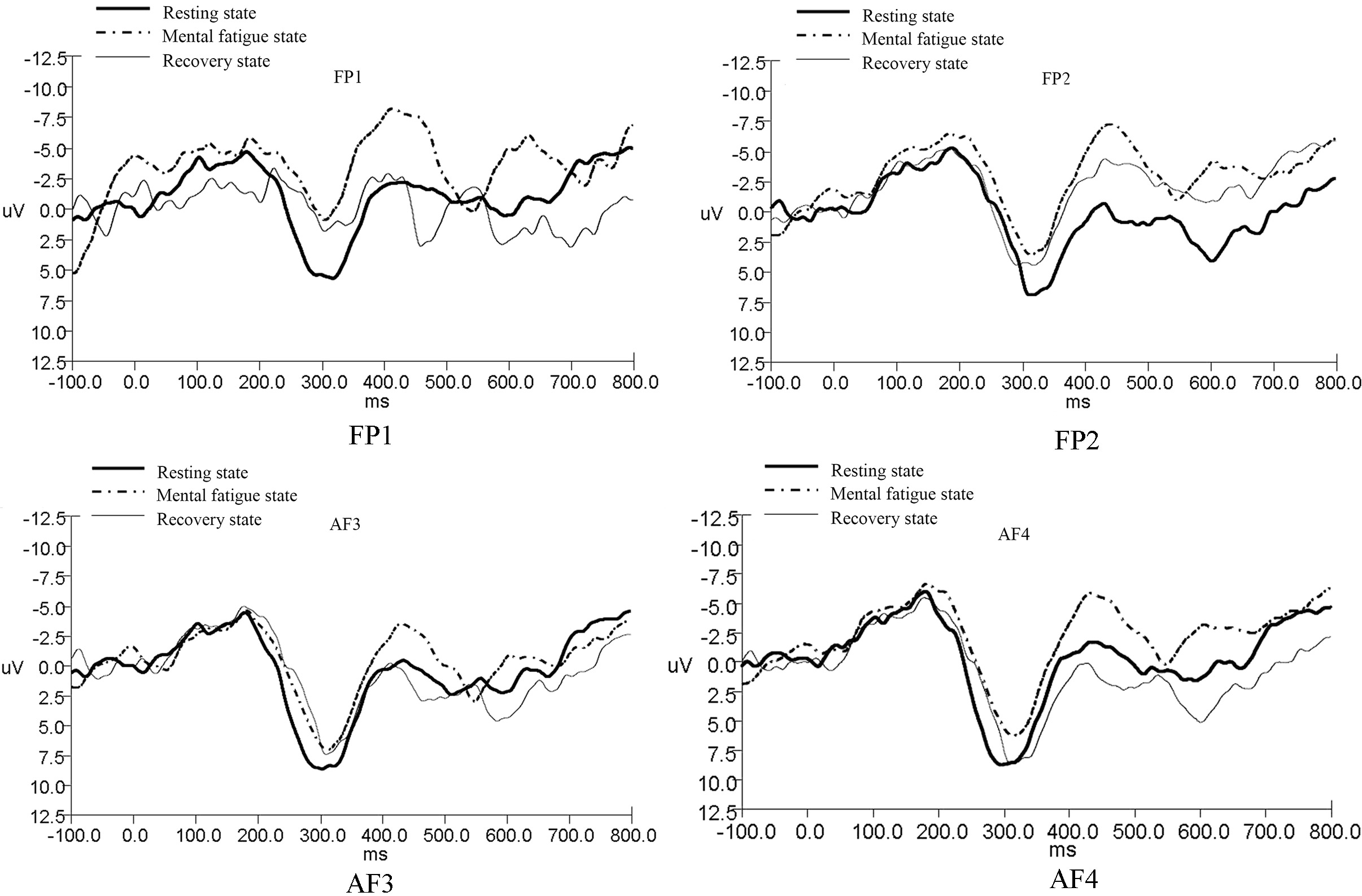
Two-way repeated-measures ANOVA, states (resting state
The mean values and standard deviations of the maximum P3a amplitudes and latencies in three states are shown in Fig. 5. The P3a data recorded in the mental fatigue state and recovery state were assessed with paired t-tests. The maximum P3a amplitude increased significantly after the subjects experienced magnetic stimulation at acupoints. No significant effects on P3a latency were identified.
Figure 5.
The amplitude and latency of P3a (
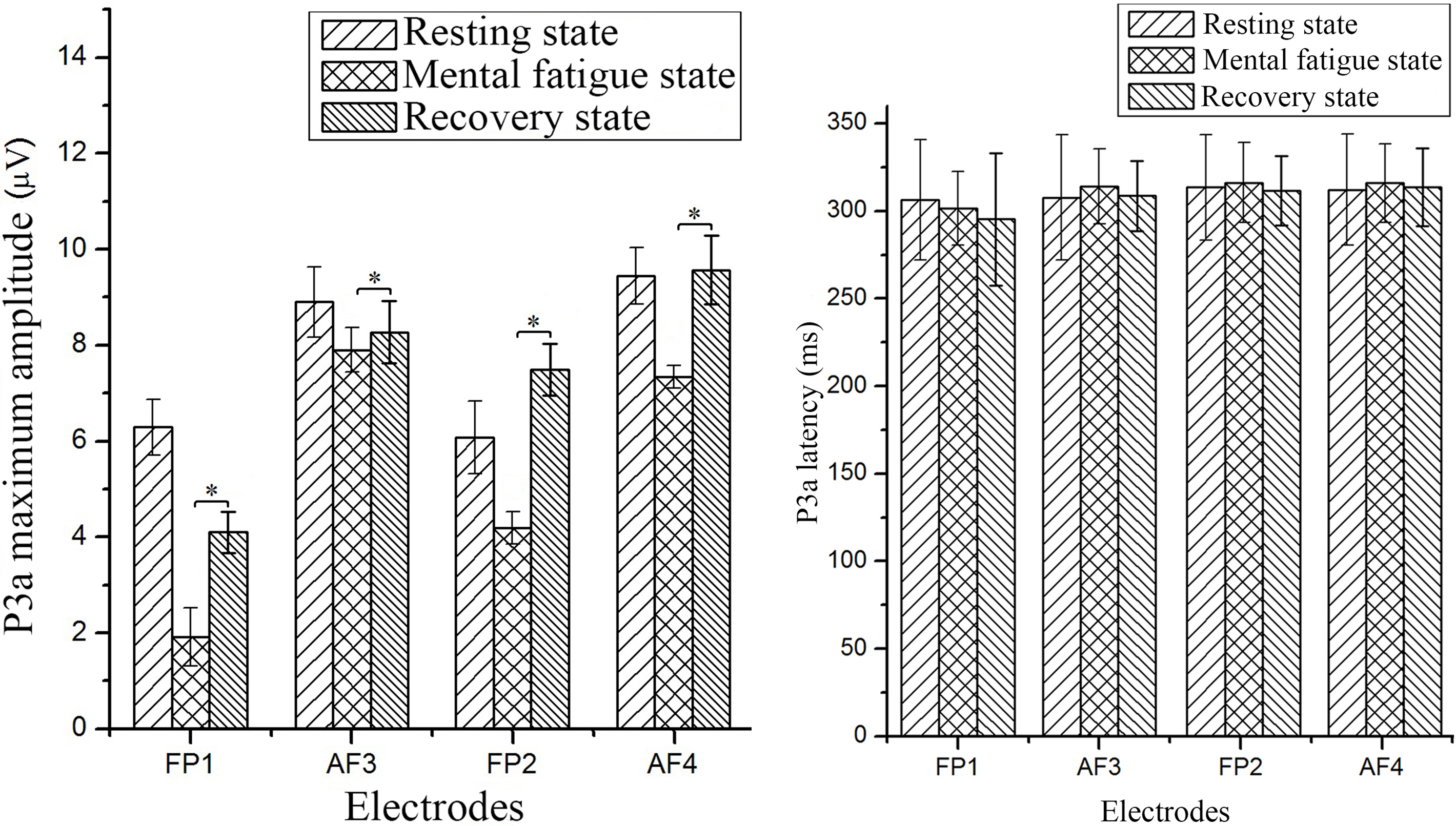
3.3P3b
Because P3b is generated from parietal activations [16], P3b waveforms recorded by six electrodes (P3, Pz, P4, PO3, POz, and PO4) were selected for analysis. The grand-averaged P3b waveforms are shown in Fig. 6.
Figure 6.
Grand-averaged ERP waveforms of P3b.
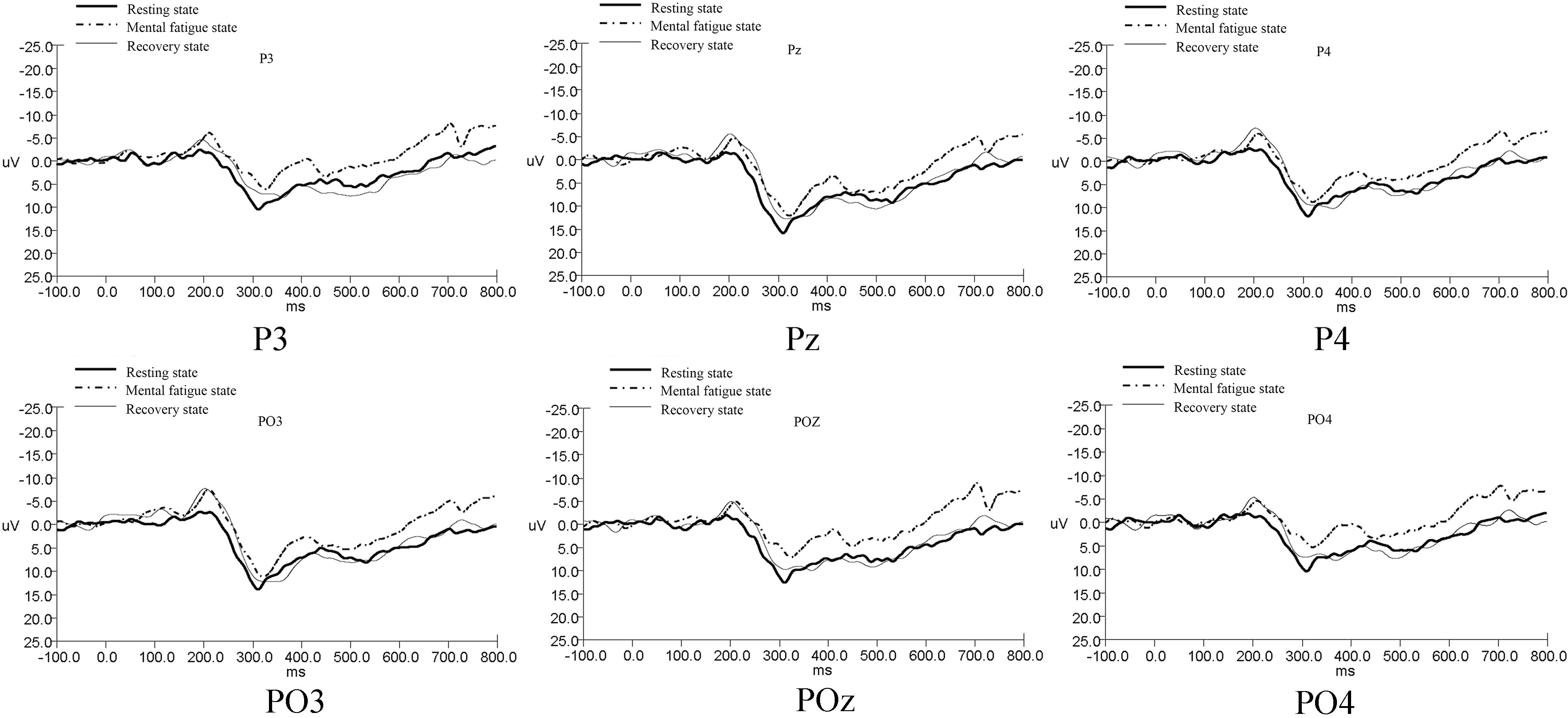
The two-way interaction repeated-measures ANOVA, states (resting state
The mean values and standard deviations of the maximum P3b amplitudes and latencies in three states are shown in Fig. 7. The P3b data recorded in both the mental fatigue state and the recovery state were assessed with paired t-tests. The maximum P3b amplitude increased significantly after the subjects experienced magnetic stimulation at acupoints. No significant effects of P3b latency were found.
Figure 7.
The amplitude and latency of P3b (

4.Discussion
The appearance of P300 is thought to reflect the allocation of cognitive resources to a task [18], and it is associated with early detection of attention and memory processing [21]. The current findings are consistent with prior evidence that P300 is reduced in many neuropsychological patients with cognitive difficulties [22, 23]. P300 amplitude is positively correlated with the amount of attentional resources allocated to a task [24], and P300 latency is closely related to the difficulty of the evaluation or categorization and how rapidly individuals can allocate attentional resources [25, 26].
Bottom-up attention and top-down attention are two basic processing methods of attention processes. Bottom-up processing refers to the external stimulus-driven attention. It starts with the body and ends in the brain. Top-down processing refers to the internal conceptually driven attention that uses existing knowledge and concepts to process. So, in top-down processing, the brain is active first. The P300 comprises two subcomponents: P3a and P3b. P3a is generated from the bottom-up attention process which originates from frontal area. P3b is generated form top-down attention process which originates from temporal–parietal area [21, 27]. In three stimulus oddball paradigm, standard stimuli are presented frequently as a background and deviant stimuli are composed of target stimuli and distracter stimuli which are infrequently presented. If sufficient attention focuses on the distracter processing, these distracter stimuli may elicit P3a, which is associated with involuntary attention. If attentional resource activated by target stimuli promotes memory storage, the target may elicit P3b, which is associated with selective attention.
This paper investigated the influence of magnetic stimulation at acupoints on mental fatigue in terms of the amount and speed of cognitive resource allocation. Compared with the resting state, the decrease in P3b amplitude during a mental fatigue state indicates that mental fatigue significantly reduces attentional resource amount allocated for target stimuli. The P3a and P3b latencies show no significant differences between the resting state and mental fatigue state, and they indicate no significant effect on the reaction speed of individuals allocating resources. After magnetic stimulation, the significant increases in P3a and P3b amplitudes indicate that magnetic stimulation at certain acupoints (HT7, LI4, and PC8) can relieve mental fatigue.
5.Conclusion
Mental fatigue caused by continuous cognitive tasks has no significant effect on involuntary attention reflecting the bottom-up process. However, it attenuates the resource allocation for selective attention and affects the top-down control detection. Thus, the P3b amplitude could be used to detect mental fatigue. Magnetic stimulation at certain acupoints (HT7, LI4, and PC8) can relieve mental fatigue.
Building on this research, our next work will explore more insights on how different bands of the signals modulate during tasks and stimulations.
Conflict of interest
None to report.
Acknowledgments
This study is supported by the National Natural Science Foundation of China, No. 31300818, No. 31400844, No. 51377045 and the Foundation of Hebei Province Department of Education, No. QN2016097.
References
[1] | Shen KQ, Li XP, Ong CJ, et al. EEG-based mental fatigue measurement using multi-class support vector machines with confidence estimate. Clin Neurophysiol. (2008) ; 119: (7): 1524-1533. |
[2] | Laurent F, Valderrama M, Besserve M, et al. Multimodal information improves the rapid detection of mental fatigue. Biomedical Signal Processing and Control. (2013) ; 8: (4): 400-408. |
[3] | Lal SKL, Craig A. A critical review of the psychophysiology of driver fatigue. Biol Psychol. (2001) ; 55: (3): 173-194. |
[4] | Zhao C, Zhao M, Liu J, Zheng C. Electroencephalogram and electrocardiograph assessment of mental fatigue in a driving simulator. Accident Anal Prev. (2012) ; 45: (1): 83-90. |
[5] | Liu J, Zhang C, Zheng C. EEG-based estimation of mental fatigue by using KPCA-HMM and complexity parameters. Biomedical Signal Processing and Control. (2010) ; 5: (2): 124-130. |
[6] | Pimenta A, Carneiro D, Neves J, Novais P. A neural network to classify fatigue from human-computer interaction. Neurocomputing. (2016) ; 172: (C): 413-426. |
[7] | Wang YY, Li XX, Liu JP, et al. Traditional Chinese medicine for chronic fatigue syndrome: A systematic review of randomized clinical trials. Complementary Therapies in Medicine. (2014) ; 22: (4): 826-833. |
[8] | Beal MW. Acupucture and oriental body work: Tranditional and biomedical concepts in holistic care: History and basic concepts. Holist Hurs Pract. (2000) ; 14: (3): 69-78. |
[9] | Ng SM, Yiu YM. Acupuncture for chronic fatigue syndrome: a randomized, sham-controlled trial with single-blinded design. Altern Ther Health M. (2013) ; 19: (4): 21-6. |
[10] | Lu C, Yang XJ, Hu J. Randomized controlled clinical trials of acupuncture and moxibustion treatment of chronic fatigue syndrome patients. Acupuncture Research. (2014) ; 4: : 313-317. |
[11] | Wang JJ, Song YJ, Wu Z, et al. Randomized controlled clinical trials of acupuncture treatment of chronic fatigue syndrome. Acupuncture Research. (2009) ; 34: (2): 120-124. |
[12] | Zhang W, Luo F, Qi Y, et al. Modulation of pain signal processing by electric acupoint stimulation: an electroencephalogram study. Journal of PEKING University. (2003) ; 35: (3): 236-240. |
[13] | Goetz SM, Weyh T, Afinowi IAA, et al. Coil design for neuromuscular magnetic stimulation based on a detailed 3-D thigh model. IEEE T Magn. (2014) ; 50: (6): 1-10. |
[14] | Lefaucheur JP, André-Obadia N, Antal A, et al. Evidence-based guidelines on the therapeutic use of repetitive transcranial magnetic stimulation (rTMS). Clin Neurophysiol. (2014) ; 125: (11): 2150-2206. |
[15] | Barker AT, Jalinous R, Freeston IL. Non-invasive magnetic stimulation of human motor cortex. Lancet. (1985) ; 1: (8437): 1106-1107. |
[16] | Scalise A, Pittaro-Cadore I, Serafini A, et al. Transcranial magnetic stimulation in sleep fragmentation: a model to better understand sleep disorders. Sleep Medicine. (2014) ; 15: (11): 1386-1391. |
[17] | Jarchi D, Sanei S, Mohseni HR, et al. Coupled particle filtering: A new approach for P300-based analysis of mental fatigue. Biomedical Signal Processing and Control. (2011) ; 6: (2): 175-185. |
[18] | Kato Y, Endo H, Kizuka T. Mental fatigue and impaired response processes: Event-related brain potentials in a Go/NoGo task. Int J Psychophysiol. (2009) ; 72: (2): 204-211. |
[19] | Akerstedt T, Gillberg M. Subjective and objective sleepiness in the active individual. Int J Neurosci. (1990) ; 52: (1-2): 29-37. |
[20] | Kim M, Lee TY, Lee S, et al. Auditory P300 as a predictor of short-term prognosis in subjects at clinical high risk for psychosis. Schizophr Res. (2015) ; 165: (2-3): 138-144. |
[21] | Polich J. Updating P300: An integrative theory of P3a and P3b. Clin Neurophysiol. (2007) ; 18: (10): 2128-2148. |
[22] | Lv J, Zhao L, Gong J, et al. Event-related potential based evidence of cognitive dysfunction in patients during the first episode of depression using a novelty oddball task. Psychiat Res. (2010) ; 182: (1): 58-66. |
[23] | Smart CM, Segalowitz SJ, Mulligan BP, et al. Attention capacity and self-report of subjective cognitive decline: A P3 ERP study. Biol Psychol. (2014) ; 103: : 144-151. |
[24] | Kok A. On the utility of P3 amplitude as a measure of processing capacity. Psychophysiology. (2001) ; 38: (3): 557-577. |
[25] | Polich J, Kok A. Cognitive and biological determinants of P300: an integrative review. Biol Psychol. (1995) ; 41: (2): 103-146. |
[26] | Fjell AM, Rosquist H, Walhovd KB. Instability in the latency of P3a/P3b brain potentials and cognitive function in aging. Neurobiol Aging. (2008) ; 30: (12): 2065-2079. |
[27] | Heitland I, Kenemans JL, Oosting RS, et al. Auditory event-related potentials (P3a, P3b) and genetic variants within the dopamine and serotonin system in healthy females. Behav Brain Res. (2013) ; 249: (14): 55-64. |




